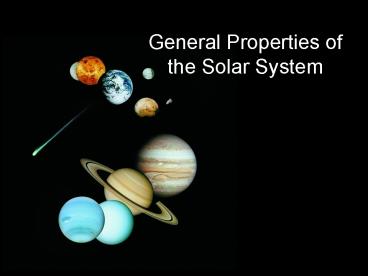General Properties of the Solar System PowerPoint PPT Presentation
1 / 23
Title: General Properties of the Solar System
1
General Properties of the Solar System
2
Announcements
- Reading for next class
- Rest of Chapter 7. first few sections of Chapter
8 - Homework 2 Due on Thursday
- Quiz Thursday
- Closed book, closed note, no electronic devices
(like it will be for the exam) - Bring a 2 pencil
- Chapter 1 sec. 5-7
- Chapter 2 sec 3-5
- Chapters 4,5,7
- Lecture material up through this Thursday
3
Todays topics
- Spectroscopy (cont.) Kirchoffs laws
- emission/absorption spectra
- Continuous spectra
- General properties of the solar system
- Basic characteristics
- Bodes law
- Planet types
- Mean density
- Inventory
4
The Modern View of Atomic Structure
- Protons, Neutrons, Electrons
- Size
- About 10-10 m (1 Å or 1 Angstrom)
- Nucleus is only 10-14 m !!
- Mass
- Protons, Neutrons 10-27 kg
- Electrons 10-31 kg
- The nucleus has most of the mass, but is less
than 0.03 by volume of the entire atom!
5
What do Atoms have to do with Planetary Science?
- Spectroscopy!
- Emission and Absorption Lines
- Each element emits/absorbs at a specific
wavelength that is unique to that element - This fact can be used to infer the composition of
a body or its atmosphere
6
Kirchoffs Laws
- A hot opaque body (blackbody) produces a smooth
continuous spectrum - A cool transparent gas in front of a source of a
continuous spectrum produces an absorption-line
spectrum - A hot transparent gas radiates an emission-line
spectrum (against a dark background)
7
Activity 1
- Give an example of something that will produce an
absorption spectrum. - (b) Give an example of something that will
produce an emission spectrum. - (c) Give an example of something that will
produce a continuous spectrum.
8
Absorption lines in the Solar Spectrum
Indicates the presence of Iron in the Sun
9
Light ScatteringThe reason the sky is blue (on
Earth!)
10
Look how dark it is in the shadow of the Apollo
11 lander
On Earth (Tucson Barrio), we can see just fine in
the shadows
11
The Green Flash
12
The Solar System
- There are two broad categories of
planetsEarthlike and Jupiterlike - All of the planets orbit the Sun in the same
direction and in almost the same plane (this is
called the ecliptic plane) - Most of the planets have nearly circular orbits
13
(No Transcript)
14
Bodes Law
- A Mathematical representation of the semi-major
axis of each planet - Not a scientific law in the usual sense
- Not based on the laws of physics it is simply a
mathematical construction - Also known as the Titius-Bode Law
- Start with the simple sequence
- 0 3 6 12 24 48 96 192 384
- Then Add 4
- 4 7 10 16 28 52 100 196 388
- Then divide by 10
- 0.4 0.7 1.0 1.6 2.8 5.2 10.0
19.2 38.8
15
Bodes Law prediction vs. actual(semi-major axis
in AU)
16
How do we know what solar-system objects are made
of ?
- Can determine the mean density and compare it to
known elements (like rock, water, and various
gases) - Need to know the objects mass and size (which we
can get from Keplers and Newtons laws and basic
trigonometry) - Spectroscopy reveals the chemical composition of
the planets and/or their atmospheres
PTYS/ASTR 206
17
Density and Mass
- The average density of any substance depends in
part on its composition - An object sinks in a fluid if its average density
is greater than that of the fluid, but rises if
its average density is less than that of the
fluid - The terrestrial (inner) planets are made of rocky
materials and have dense iron cores, which gives
these planets high average densities - The Jovian (outer) planets are composed primarily
of light elements such as hydrogen and helium,
which gives these planets low average densities
Volume of a Sphere
PTYS/ASTR 206
Telescopes / Solar System 2/12/08
18
Activity 2
- Scientists just recently discovered the
smallest known transiting extrasolar planet (Feb
3, Science News). The article states that the
planet has a mass that is about 10 times larger
than Earths mass, and its diameter is about
twice as large. Do you expect that this planet
has a larger or smaller mean density than Earth?
By how much?
19
(No Transcript)
20
(No Transcript)
21
(No Transcript)
22
(No Transcript)
23
(No Transcript)

